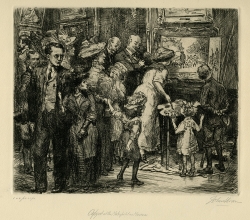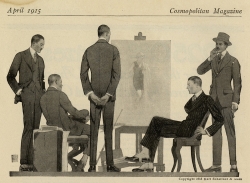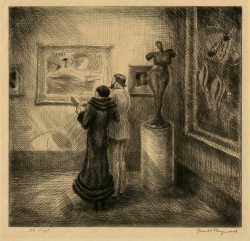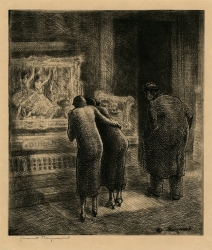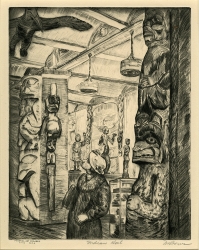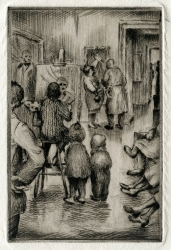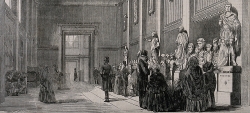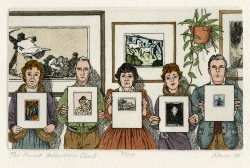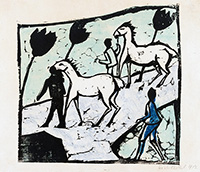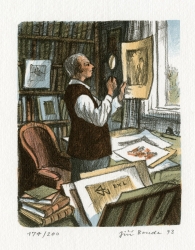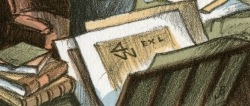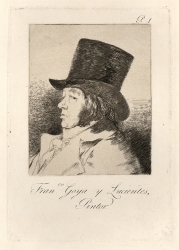Have you ever observed people visiting an art gallery or museum? Artists have found the act of viewing to be a rich resource for exloration in pictorial terms. In such works we as viewers are once removed from the scene, observing from over the shoulder of the artist. It’s interesting to see the various perspectives on public engagement with art. There are some unusual and insightful examples of the phenomenon in the University Art Collection. In these often familiar scenes we might feel like voyeurs observing the observed.
Artist depictions of the act of viewing and reacting to visual art can be a fascinating genre with various interpretations and implications, both self-referential and satirical. Recently this imagery has taken on a new layer of significance. In this time of social distancing and closures, the opportunity to experience pictures at a museum or other venue is no longer an option. It’s hard to imagine how we could have taken this amazing privilege—a staple component of our cultural DNA—for granted.
Copyist at the Metropolitan Museum
John Sloan (1871-1951)
Copyist at the Metropolitan Museum
1908
Etching
Library Purchase
2014.25.3
John Sloan was fond of sketching viewers at the museum, and made a successful career depicting his fellow New Yorkers engaged in everyday activities. Sloan was associated with the socially minded Ashcan School and the group of artists known as the Eight. The latter exhibited together only once, the year this etching was created, but their focus on the realism of daily life was highly influential in American art. In this etching, visitors hover around an artist who is copying from one of the paintings in the collection. This is a practice supported by cultural institutions for the benefit of living artists and the cultivation of art for future generations. In his diary of September 1908, Sloan referred to the painting as a “sheep picture.”[1] One can clearly discern the sheep in the composition along with a wealth of other detail, such as faces, clothing and body language. Sloan included himself and his wife Dolly standing at far left, apparently less fascinated than the other museum-goers.
Admiring a Painting [Hart Schaffner & Marx Advertisement]
John Emmet Sheridan (1877-1948)
Admiring a Painting [Hart Schaffner & Marx Advertisement]
1915
Commercial offset printing
Gift of Richard J. Cellini
2015.4.41
John Sheridan was a successful magazine and advertising illustrator. He attended Georgetown at the turn of the 20th century and paid for part of his tuition by creating popular posters for campus sports events. Some of his drawings also appeared in Ye Domesday Booke. His classic illustrations graced the cover of The Saturday Evening Post, Collier’s Weekly and Ladies Home Journal. He also created numerous posters during World War I. Sheridan was a master of figural drawing and his style was perfectly suited to advertise the sartorial designs of the classic clothiers Hart Schaffner and Marx. This is a sheet from the April 1915 issue of Cosmopolitan magazine.
At an Exhibition
Grant Reynard (1887-1968)
At an Exhibition
Not dated
Etching (edition of 50)
Gift of Jay Friedenberg
2014.11.2
These two etchings by Grant Reynard convey subtle humor with attention to detail as in John Sloan's etching above. With the aid of a guidebook, a couple at a museum pause to study a modernist painting. A diagonal axis from upper right to bottom left starts at the head of the sculpture and draws our eye down to the heads of the two figures. This unites the three, contrasting the inanimate bronze with the corporeality of the human forms. The sculpture appears to take on life in a twisting pose, suggesting consciousness of its unclothed state. The artist creates a similar contrast between the nude in the painting and the elegantly dressed couple.
Art Dealer’s Window
Grant Reynard
Art Dealer’s Window
1936
Etching
Gift of Jay Friedenberg
2014.11.1
This storefront with two window shoppers admiring paintings reveals several layers of meaning. Starting with the male figure on the right, it appears he is more interested in the posterior view of the women than the artwork on display. The sign beneath the window identifies the gallery as that of Paul Durand-Ruel, the influential dealer who was among the first to discover and promote the French Impressionist artists to consumers in Paris. In 1876, his gallery presented the work of Monet, Pissarro, Sisley, Degas, Renoir, Manet and others, following the first exhibition of their work at the photographer Nadar’s gallery in 1874. In this etching we can identify dancers in the storefront painting; presumably the work of Edgar Degas. Over the course of his career, Durand-Ruel amassed more than 400 works by Degas. It is amazing to consider that such a major painting could be not only available for purchase on the open market, but also displayed in a such a vulnerable position close to the front door, exposed to sunlight, atmospheric pollution and potential theft.
Grant Reynard was a freelance illustrator for the major magazines of his day including The Saturday Evening Post and Harper’s Bazaar. He studied etching in Europe and was active in the MacDowell summer art colony in New Hampshire for several years.
Indian Hall
Mortimer Borne (1902-1987)
Indian Hall
1934
Drypoint
Recent Purchase
This scene emphasizes the oftentimes overwhelming experience when encountering an ancient culture, especially when removed from its native setting and context. The venue of this ethnographic display is the Museum of Natural History, New York. The print was created for the Federal Art Project during Roosevelt’s New Deal administration which kept artists employed by commissioning works reflective of contemporary life.
Mortimer Borne was a Polish-born artist who emigrated to the U.S. in 1916 at the age of fourteen. He studied art at various academies in and around New York and taught at the New School for Social Research. Borne was devoted to the etching technique. and pioneered the color drypoint process. At his home in Nyack, New York, Borne later established the Tappan Zee Art Center.
Art Appreciation
Marguerite Kumm (1902-1992)
Art Appreciation
1946
Drypoint
Gift of the Artist
1992.2.3
Similar in theme to Copyist at the Metropolitan Museum, Marguerite Kumm’s Art Appreciation depicts an artist copying from a museum work. Attention is immediately drawn to the two central figures of children in rapt attention of the artist at work. The artist is making a faithful rendering of the portrait on the wall. From there, they eye is drawn further into the composition to the couple in the background, engaged in conversation about the work in front of them. In the far distance, we see a sliver of a figure in the doorway of the adjoining gallery. The odd and irreverent cropping of this scene, with three pairs of crossed legs at right and a partial figure at left suggests the artist was working from a photograph.
Museum Visitors
Marguerite Kumm
Museum Visitors
1977
Drypoint
Gift of the Artist
1992.2.307
This print reveals how visitors can get distracted by other people in the museum. Note the trio in the background, where one figure stares out at the woman bending forward to examine an artiwork. As viewers we participate in the scene by reflecting his gaze. In this tightly packed and narrow composition we also get a sense of the crowded conditions in many popular museum exhibitions.
Marguerite Kumm received her art degree at the Corcoran School of Art in painting and etching. Although born in Minnesota, she lived most of her life in Washington, D.C. and made a living through commissions for commercial design and illustration. She donated her entire graphic oeuvre to Georgetown in 1992 along with her personal archive. Kumm’s work was featured in the grant-funded 2016 exhibition Undiscovered Printmakers at Georgetown University Library.
Untitled [people in a museum, for USA magazine]
Lynd Ward (1905-1985)
Untitled [people in a museum, for USA magazine]
Not dated
Wood engraving
Gift of Robin Ward Savage and Nanda Weedon Ward
1981.1.1155
With a wealth of visual detail, Lynd Ward effectively combines several types of visitor experiences in one scene. A group of people in the center of the composition divides the scene into two distinct groups. Three figures on the far right pose for a photograph being taken by the figure in profile at far left. Several paintings line the walls of the museum, drawing the viewer deeper into the scene. In the depths of the gallery, two colossal sculptures (perhaps Jupiter and Hera) are surrounded by a cluster of onlookers apparently on a guided tour.
Lynd Ward was a prolific, award-winning mid-century book illustrator and pioneer of the graphic novel in America. His first wood engraved, wordless novel, Gods’ Man ,appeared in 1929, followed by five additional stories in the following decade. Thanks to the artist and his family, Georgetown owns the largest institutional collection of Ward’s graphic work and has mounted four exhibitions beginning with a retrospective in 1983.
The linearity and spatial recession of this scene compares with another wood engraving of about a century earlier: The British Museum: the Roman Saloon, with visitors. Wood engraving attributed to J. and A. Williams, 1857. Credit: Wellcome Collection. Attribution 4.0 International (CC BY 4.0)
The Print Collector's Club
Abigail Rorer (Contemporary)
The Print Collector’s Club
1984
Etching with hand-coloring, 53/75
2000.30.2
Abigail Rorer is a distinguished wood engraver and book illustrator with an eye for minute detail and a special interest in botanical and animal subjects. Her work has appeared in numerous fine press editions published by the Lone Oak Press in Massachusetts, which she founded in 1989; Barbarian Press, and others. This diminutive etching reveals her skill in portraiture as well as her appreciation of the great printmakers of the past. The prints on the wall are clearly identifiable: Francisco de Goya’s Well-Known Folly (Disparate conocido) from the series Los Disparates c. 1815-23; a reverse image of Erich Heckel’s White Horses (Weisse Pferde), 1912; and possibly a nude by Renoir. Due to the fine level of detail we can also identify most of the handheld prints. Standing in a line, the collectors appear to pose for a photograph while holding up their prized possessions.
Heckel image source: Karl&Faber, DE.
Print Collector
Jiří Bouda (1934-2015)
Print Collector
1993
Color lithograph, 174/200
2002.16.1
Print Collector presents a connoisseur in his study or art cabinet quietly examining one of his prints. Holding it up to a window and looking through a magnifying lens, the collector may find details such as the watermark in the paper, subtleties in the impression indicative of its state, or the artist’s signature. These attributes of fine prints determine authenticity and contribute to market value. Collectors may search for years to find that elusive impression by an artist they admire that will round out their collection.
Jiří Bouda was a Czech painter and graphic artist who specialized in scenes of his native countryside and railways. He also won commissions for postage stamps and exlibris, or book plate designs, of which this is one. The exlibiris initials along with a monogram are visible on the paper in the wooden cradle.
The Connoisseur
Barry Moser (Contemporary)
The Connoisseur
1985
Wood engraving
Gift of Pamela Hatay-Stratton and David Stratton
1988.7.1
Barry Moser is among the most highly regarded wood engravers working today, and a master of the art of the book. He established the Pennyroyal Press, purveyor of fine press editions and broadsides since 1970, and has illustrated over 200 books. In 1982, Moser published an edition of Alice’s Adventures in Wonderland, which won the 1983 American Book Award for Design and Illustration. The following year he released its successor, Through the Looking Glass and What Alice Found There. Created shortly thereafter, The Connoisseur is a double self-portrait of the artist in a top hat. In speaking of another top-hatted self-portrait, Moser explained he had been thinking a lot about the character of the Mad Hatter. Another source of inspiration might have been Goya’s self-portrait published in his famous series of satirical etchings, Los caprichos (1799). The subject in The Connoisseur admires his self-portrait, held as if mirroring Moser’s face in a clever visual conceit.
Pictures at an Exhibition
Lila Oliver Asher (Contemporary)
Pictures at an Exhibition
Linoleum block print with hand coloring
Gift of Ingrid Rose in Memory of Milton M. Rose
2018.4.59
This panoramic linoleum cut by Lila Oliver Asher suggests the interplay of music and visual art. The title borrows from Modest Mussorgsky’s famous 1874 piano composition. The silhouetted black figures resemble notes on a musical score and the six large pictures on the wall could be interpreted as separate and distinct compositions within Mussorgsky’s suite ot ten movements.
Lila Asher is a distinguished local printmaker who taught art at Howard University from 1948 to 1991. Her lyrical, white line linoleum cuts have been exhibited at venues around the city and have prompted critics to compare them with the graphic work of Matisse. Thanks to generous donations from Ingrid Rose, Georgetown holds more than forty prints by Lila Asher.
Inner Music
Dario Zucchi (Contemporary)
Inner Music
Digital print
Gift of Eric Denker in honor of the artist
2017.8.4
Dario Zucchi has devoted years to the careful study of visitors at the art museum, notably the National Gallery of Art where his wife has worked as a docent, and elsewhere. Zucchi waits until he sees an interesting spontaneous overlap between a visitor and the artwork he or she is looking at. After asking for permission, the artist takes carefully framed images that often have an ironic or humorous undertone. The featured painting in Inner Music is Picasso’s Three Musicians, in the collection of the Museum of Modern Art in New York. Painted in 1921, it is generally accepted as a self-portrait of the artist as a Harlequin between his two poet friends Guillaume Apollinaire and Max Jacob. With the saxophone, guitar and sheet music, it almost feels like this museum visitor is listening to a lively jazz concert, as well as viewing a two dimensional work of art.
A nearby resident and a proud Hoya parent, Zucchi exhibits his work at local venues such as the Italian Embassy and Strathmore Art Center as well as venues in Italy. In 2017, his friend and curator Eric Denker—Senior Lecturer at the National Gallery—donated a selection of Zucchi’s artwork to the Library. More examples may be seen online.
Curated by LuLen Walker, University Art Collection Curator

